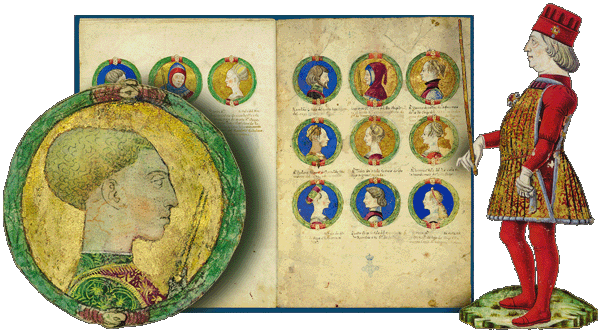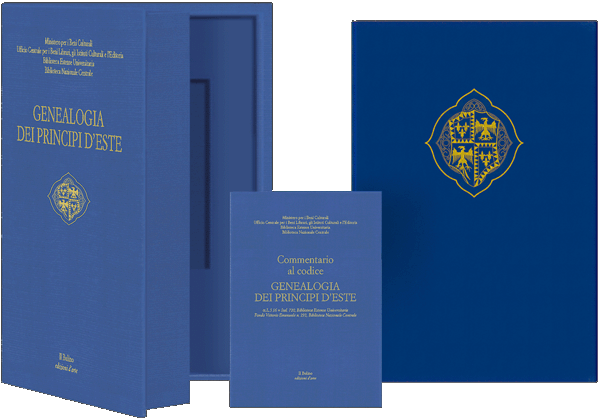  

  
Illuminated manuscript
on parchment
cm 25x32, 1474 ca.
ISBN 88-86251-20-3
Price: € 1.400,00
|
|
GENEALOGY OF THE D’ESTE PRINCES
the portrait gallery of the dukes of Ferrara
a.L.5.16 = Ital. 720, Biblioteca Estense Universitaria, Modena
Biblioteca Nazionale Centrale, Roma, fondo Vitt. Emanuele n. 293, cc. i-8-ii

The illuminated codex on parchment (1474-1479 c.) consists of two fragments, one preserved in Modena, the other in Rome. The Italian Ministry of Culture promoted their reunification by entrusting the task of producing an exclusive facsimile edition to Il Bulino, with the aim of highlighting the artistic heritage of Italian public libraries and encouraging its appreciation. The manuscript consists of 169 portraits of the princes and members of the House of Este from its origin to the beginning of the 16th century, from Alberto Azzo, the first vicar of Ferrara (1095) to Isabella d’Este-Gonzaga (1474). The last sheet of the Modena fragment shows four medallions ready for the next four children of Ercole I, up to Ippolito, born 20 March 1479; from this the dating of the codex was deduced. It is definitely the work of a court artist, thought to be either Bonifacio Bembo or Baldassarre d’Este. The codex, commissioned by the Estense family, belonged to Cardinal Alexander until his death in 1625, when it passed to the Teatini Order; in Reggio Emilia it was unexpectedly split up and lost. The fragment made up of two external sheets returned to the Estense Library after the Order was abolished in 1782 while the four central sheets reappeared in 1886 and were purchased by the State for the National Library in Rome, for at the time they were not known to be part of the Estense codex.
The manuscript, unique in its genealogical interest, iconography and as a history of dress, was intended as a courtly “family album” to show to important guests and to flaunt the family’s wealth, power and illustrious origins. Nine portraits per page were planned, though not all pages were completed. The 169 family members, portrayed in medallions, are shown as busts.
The faces are water-coloured on a deep blue or gold background. The gold background is only used for reigning princes, shown holding a staff, and their consorts.
The texts under the medallions, in the dialect of Ferrara, identify the person and give essential biographical details. For the most important princes there is a lot of information.
Just the portrait of Borso d’Este is different. The complete figure, taking up a whole page, is shown standing on grass, showily dressed in red and gold and holding a sceptre. This is not only to emphasises his leading role in the family, but it is also a posthumous thanks from Ercole I to his brother, who chose him as his successor instead of the legitimate pretender.
Facsimile edition
The facsimile edition (size 25 × 36 cm) reunites the two original fragments. It has been presented by Antonio Paolucci at the Biblioteca Estense and by Andrea Emiliani at the Biblioteca Ariostea in Ferrara. The gold background is applied with heat impressions. The binding is in blue velvet stamped with the Este coat-of-arms in gold. This edition, with 208 page commentary, is limited to 333 numbered and certified copies.

|
|




